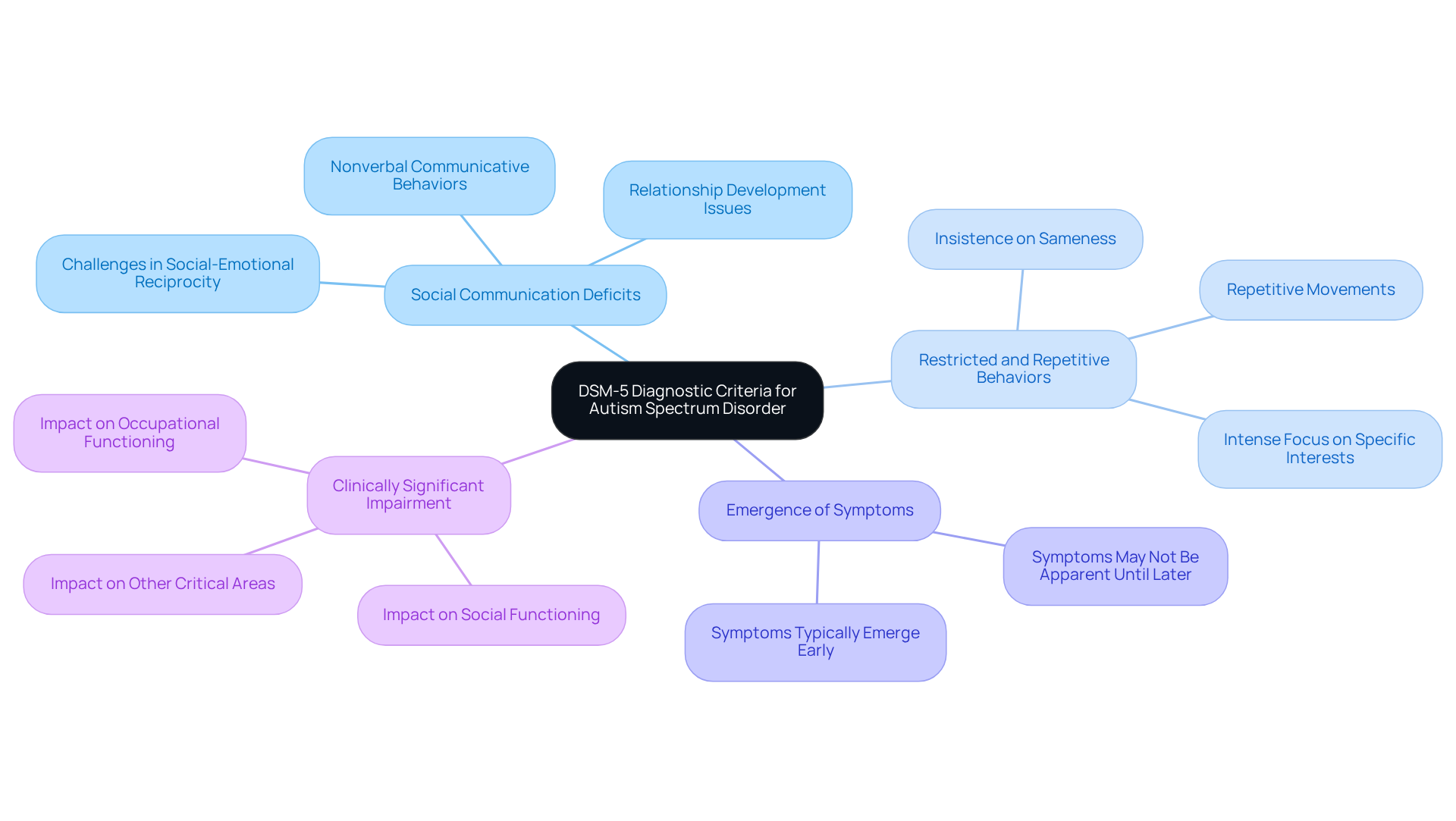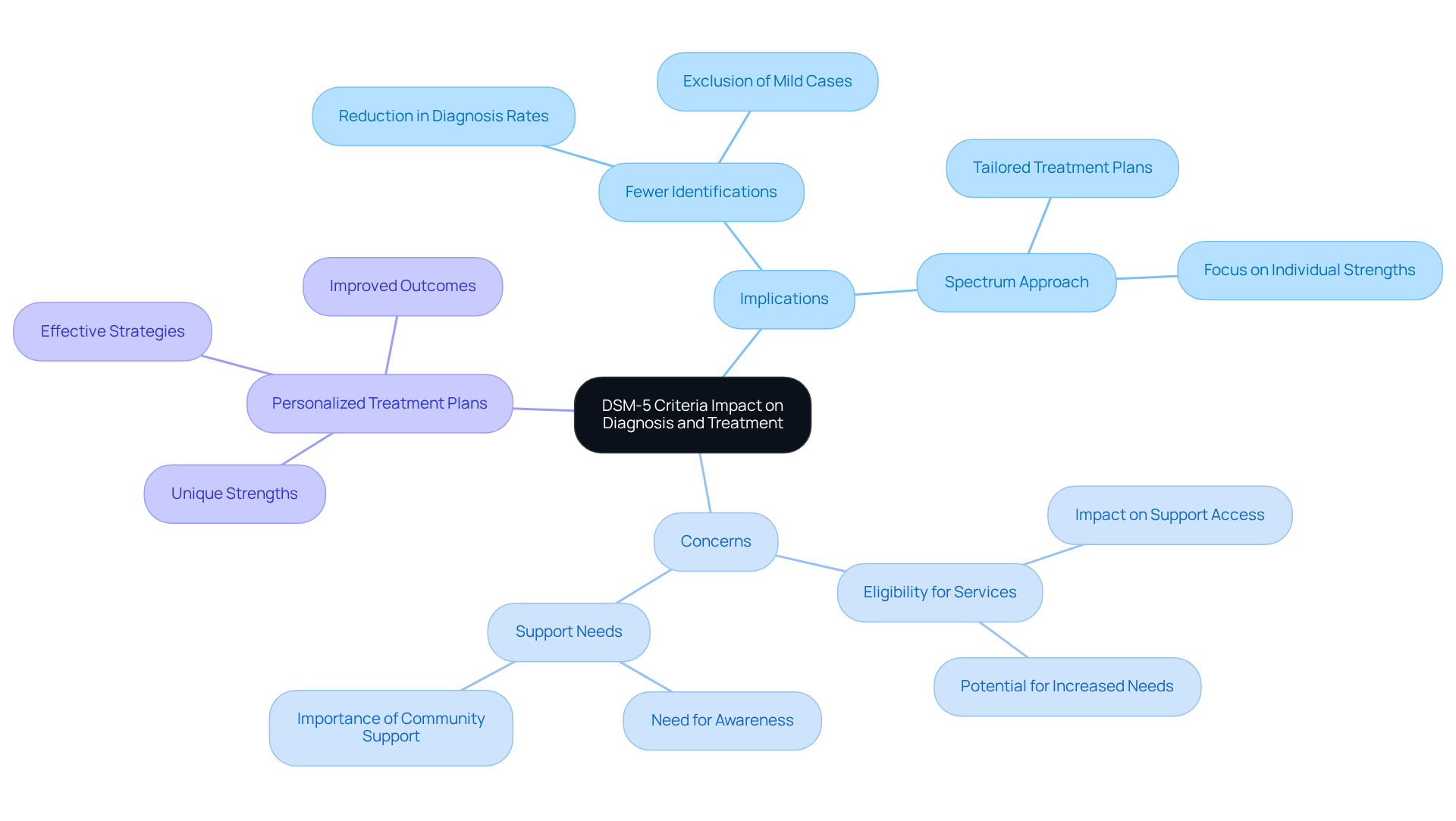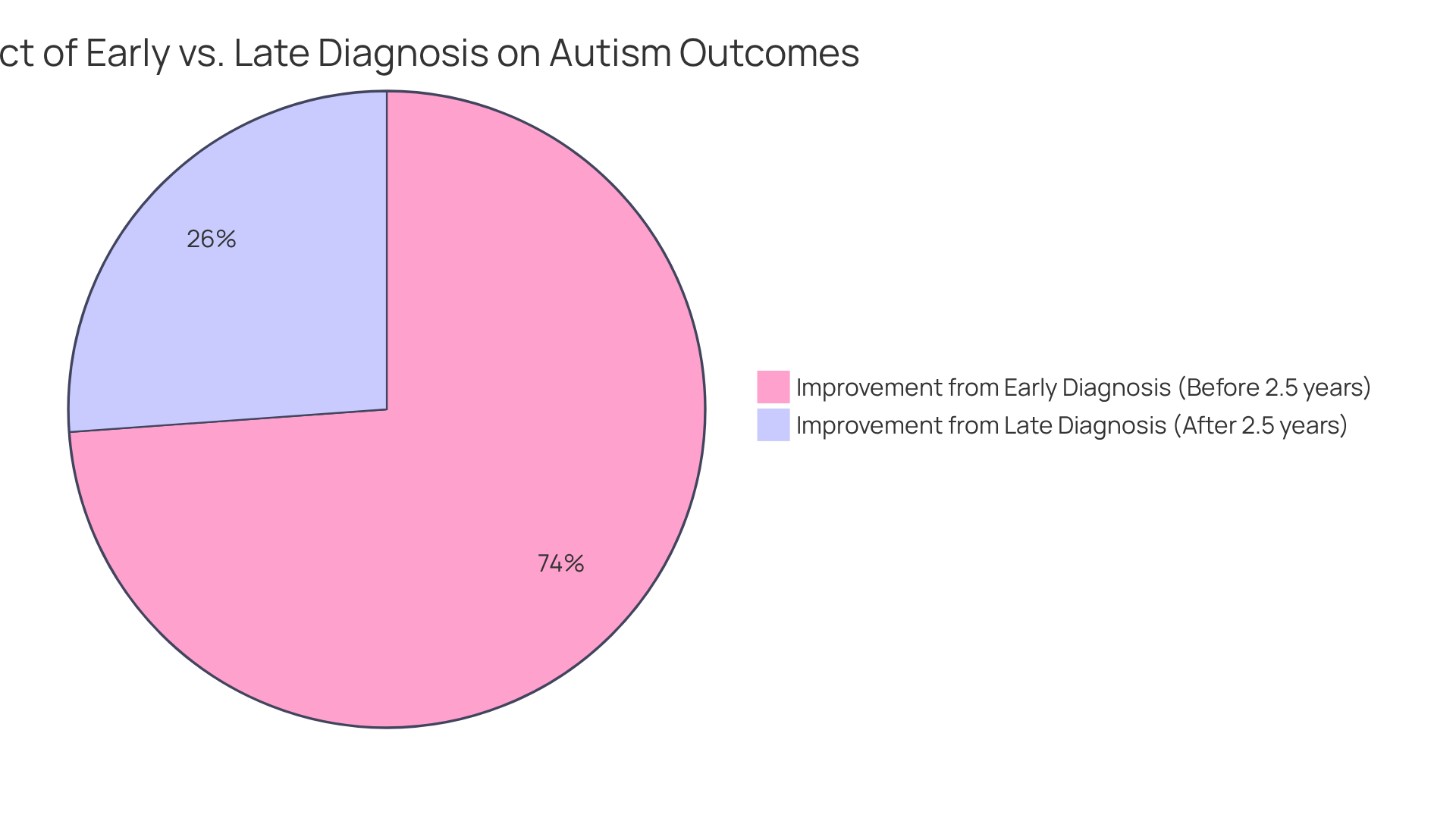Overview
This article highlights the importance of understanding Autism Spectrum Disorder (ASD) as defined by the DSM-5, aiming to provide effective support for individuals affected by it. Early diagnosis and personalized interventions based on DSM-5 criteria are crucial, as they can significantly enhance developmental outcomes. Research shows that early identification leads to remarkable improvements in communication and social skills, helping to address the unique challenges faced by those with ASD. By sharing insights and resources, we hope to empower families on this journey.
Introduction
Understanding Autism Spectrum Disorder (ASD) is essential in a world where approximately 1 in 36 children are diagnosed with this intricate developmental condition. The DSM-5 provides a framework that reclassifies various autism-related disorders and highlights the spectrum nature of ASD, fostering a more nuanced understanding of individual experiences. Yet, with evolving diagnostic criteria, families may wonder: how can they ensure they receive the most effective support amidst these changes?
This article explores the complexities of DSM autism spectrum disorder, shedding light on its classification and diagnostic criteria. Most importantly, we will discuss the vital role of early intervention and personalized support for those navigating this journey together.
Define Autism Spectrum Disorder and Its DSM Classification
Autism Spectrum Disorder (ASD) is a complex developmental condition that many families navigate, characterized by ongoing challenges in social communication and interaction, as well as restricted and repetitive behaviors. The Diagnostic and Statistical Manual of Mental Disorders (DSM-5) categorizes various experiences under the label of dsm autism spectrum disorder, which includes previously separate disorders like autistic disorder and Asperger's syndrome. This thoughtful reclassification reflects a deeper understanding of autism as a spectrum, recognizing that individuals can exhibit a broad range of symptoms and levels of severity.
Understanding ASD is essential for providing the right support. The dsm autism spectrum disorder emphasizes that identifying ASD involves a careful mix of behavioral observations and developmental history. This approach helps clinicians tailor treatments effectively, ensuring that each individual receives the care they need. If you or someone you know is facing these challenges, remember that you are not alone. There are resources and support systems available to help navigate this journey together.
Explore DSM-5 Diagnostic Criteria for Autism Spectrum Disorder
The DSM-5 outlines essential diagnostic criteria for DSM Autism Spectrum Disorder (ASD), which are vital for accurate identification and effective intervention. These criteria include:
- Persistent deficits in social communication and interaction across various contexts, marked by challenges in social-emotional reciprocity, nonverbal communicative behaviors, and relationship development.
- Restricted and repetitive patterns of behavior, interests, or activities, which may manifest as repetitive movements, insistence on sameness, or intense focus on specific interests.
- Symptoms typically emerge during the early developmental period, though they might not become fully apparent until social demands exceed the individual's limited capacities.
- These disturbances must result in clinically significant impairment in social, occupational, or other critical areas of functioning.
Understanding these criteria is crucial, especially since studies indicate that approximately 1 in 36 children are diagnosed with ASD, with the average age of diagnosis in the U.S. being around 5 years. Clinicians stress the importance of recognizing persistent deficits in social communication, as these challenges often surface in early childhood and can significantly affect a child's development and quality of life. Dr. Jeremy Veenstra-VanderWeele highlights that early identification of these signs is key to taking effective action.
Utilizing the DSM Autism Spectrum Disorder criteria accurately not only aids in identification but also informs tailored intervention strategies that can enhance outcomes for individuals with ASD. Furthermore, recent updates to the criteria for DSM Autism Spectrum Disorder in the DSM-5 have contributed to an increase in autism identifications, underscoring the need for prompt and efficient assessment methods. Notably, children born in 2016 were 1.6 times more likely to be identified with ASD by age 4 compared to those born in 2012, reflecting the growing awareness of the disorder.

Discuss Implications of DSM-5 Criteria on Diagnosis and Treatment
Understanding the DSM autism spectrum disorder criteria for identifying Autism Spectrum Disorder (ASD) is crucial for parents navigating this journey. The recent changes, particularly the consolidation of distinct classifications into a single DSM autism spectrum disorder category, may result in fewer individuals being identified under the new criteria. This shift can understandably raise concerns about eligibility for services and support, as some who once qualified for assessments might find themselves outside the new parameters.
However, it’s important to recognize that this evolution also emphasizes a spectrum approach, which can be incredibly beneficial. By focusing on the unique strengths and challenges of each individual diagnosed with DSM autism spectrum disorder, we can create more personalized treatment plans. This tailored method not only addresses the specific needs of each person but can also lead to more effective strategies and improved outcomes for families.
As we navigate these changes together, it’s essential to stay informed and connected. Sharing experiences, asking questions, and seeking support can make a significant difference in how we approach these challenges. Remember, you are not alone in this journey, and there are resources available to help you every step of the way.

Highlight Importance of Early Diagnosis and Customized Support
Prompt identification of dsm autism spectrum disorder is essential for ensuring that children receive timely support, which can lead to significant improvements in their developmental outcomes. Research shows that individuals diagnosed before the age of 2.5 experience a remarkable 65% improvement in their Autism Diagnostic Observation Schedule-Second Edition Calibrated Severity Scores, compared to just 23% for those diagnosed later. This highlights the critical importance of early intervention in enhancing communication, social skills, and behavior. However, it's important to recognize that only 8%-33% of youth with dsm autism spectrum disorder demonstrate improvements in ADOS-2 CSS between ages 1.5 and 6 years, underscoring the urgent need for early diagnosis and support.
Personalized assistance tailored to the unique needs of each individual is vital for effectively addressing specific challenges and leveraging personal strengths. Such individualized approaches not only enhance the effectiveness of interventions but also empower families to navigate the complexities of ASD with increased confidence. For instance, the case study titled 'Supporting Smooth Transitions for Individuals with Autism' illustrates how implementing targeted ABA strategies has led to smoother transitions for these individuals, reducing anxiety and improving adaptability.
Moreover, experts like Ditza A Zachor emphasize that early identification of dsm autism spectrum disorder within the community is associated with significant improvements in social symptoms within 1-2 years. By prioritizing early diagnosis and customized support, parents and professionals can collaborate effectively to unlock the potential of individuals with autism, fostering an environment where they can thrive and develop essential life skills. Additionally, addressing trauma considerations in the context of dsm autism spectrum disorder can offer a more holistic view of the challenges faced by children with ASD, further enhancing the effectiveness of tailored interventions.

Conclusion
Understanding Autism Spectrum Disorder (ASD) through the lens of the DSM-5 is crucial for providing effective support and intervention. This comprehensive classification not only consolidates various previously distinct disorders but also emphasizes the spectrum nature of autism, highlighting the diverse experiences and challenges faced by individuals. By recognizing that ASD encompasses a wide range of symptoms and severity levels, caregivers and professionals can better tailor their approaches to meet the unique needs of each individual.
The article outlines the essential DSM-5 diagnostic criteria for ASD, emphasizing the importance of early identification and intervention. Key insights reveal that timely diagnosis can significantly enhance developmental outcomes, with research indicating that early support leads to remarkable improvements in communication and social skills. Furthermore, the shift towards a more personalized treatment approach underscores the need for individualized strategies that address specific challenges while leveraging individual strengths.
Ultimately, prioritizing early diagnosis and customized support is vital for unlocking the potential of individuals with autism. By fostering collaboration among parents, professionals, and the community, a supportive environment can be created that nurtures growth and development. Embracing the insights shared in this article can lead to more informed decisions and effective strategies, ensuring that individuals with ASD receive the care and support they deserve.
Frequently Asked Questions
What is Autism Spectrum Disorder (ASD)?
Autism Spectrum Disorder (ASD) is a complex developmental condition characterized by ongoing challenges in social communication and interaction, along with restricted and repetitive behaviors.
How does the DSM-5 classify Autism Spectrum Disorder?
The DSM-5 classifies Autism Spectrum Disorder as a spectrum that includes various experiences previously categorized as separate disorders, such as autistic disorder and Asperger's syndrome, reflecting a broader understanding of autism.
Why is understanding ASD important?
Understanding ASD is crucial for providing appropriate support, as it helps clinicians tailor treatments effectively based on individual needs.
How is ASD identified?
Identifying ASD involves a careful combination of behavioral observations and developmental history, allowing for a more accurate diagnosis and effective treatment planning.
What should individuals do if they or someone they know is facing challenges related to ASD?
It is important to know that you are not alone; there are resources and support systems available to help navigate the challenges associated with Autism Spectrum Disorder.




